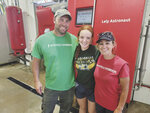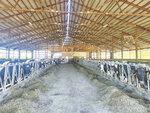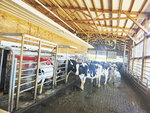


BLANCHARDVILLE, Wis. — In 2016, Farron and Jessica Gruenenfelder were considering an upgrade from milking 70 cows in a tiestall barn to milking with robotic milking units.
“We were almost going to sign the papers to do robots and I got cold feet,” Farron said. “It’s a lot of money.”
Instead, the couple built a freestall barn and double-10 step-up parlor. They expanded to 180 cows and hired employees to help with milking. When their hired help decided to move, the Gruenenfelders revisited the idea of robotic milking units.
This time, they leaped. Jessica said they have not looked back.
“We ask ourselves now why we didn’t do this sooner,” Jessica said. “But nobody gets to start out on top. You’ve got to work your way up.”
Farron and Jessica are second-generation farmers who purchased the dairy in 2009. They have four children — Trinity, Aidan, Layton and Atley. They installed two Lely A5 robots and one Lely Juno in July 2023. The upgrade in equipment required a downsize in cow numbers, and they now milk 120 Holsteins.
Their sand bedded freestall barn has four rows with the robotic milking units on one end.
Since the switch, their cows have increased milk production by 12 pounds per cow per day. Farron said there seems to be less mastitis with more milkings per day. The herd is averaging close to three-times-a-day milking.
Besides cow health, the couple said the biggest impact has been on their lifestyle. Jessica said the flexibility of chores has made the change worth it.
“I feel like our cows are calmer and just more relaxed,” Jessica said. “There’s certain things we have to maintain, but it’s a way better quality of life.”
Farron and Jessica operate the farm together and their kids help out when they can. The robots have eliminated the need for hired employees. Each day, the couple gets to the farm around 4 a.m. They begin by scraping the barns, feeding calves and mixing feed.
The cows have developed habits in the year since transitioning. Jessica said the robots are busy around 11 p.m. and the cows tend to visit throughout the night. When the morning chores start, cows usually start going through again, and by the time the robots shut down for washing at 8 a.m., Farron has fresh feed at the bunks and most are done milking.
A footbath is positioned on the same end as the robots. Farron said it gets good use and does not seem to slow down the milking flow. They periodically run the herd through the footbath, so they know every cow is being treated.
When designing the upgrade, the Gruenenfelders originally planned to install three robots. At the last minute, they changed their minds and went with two. When this change occurred, they lost the opportunity to include a calving pen in the design. Farron said that is one thing he would go back to change. However, it is designed so two additional robots could be installed if a future expansion were to happen.
Right now, the barn is at capacity with 116 stalls. The Gruenenfelders said there does not seem to be an issue with overcrowding since not all cows are on the same schedule. At any given time, there is a group milking, a group eating and a group lying down.
The biggest disruption that has occurred so far was the result of bad weather. In a storm that was severe enough to pull the roof off a shed, the robots lost power overnight. Before retiring for the night, Farron had hooked up the generator as a precaution. They watched a few cows go through the robot and everything seemed to be working so they went in for the night.
They received no calls overnight and assumed everything was OK until they got to the barn and heard the cows bellering. Evidently, the modem for the internet had been struck and when the cows went through the robot, their identification collars were not recognized and it pushed them through without milking them.
Jessica said they were grateful for the support of their Lely dealers to get them through.
“By the time we realized what had happened, Lely was on it,” Jessica said. “They were here helping us out and the problem was solved.”
The local internet provider and power company provided support as well.
Overall, Farron said the upgrade has proved worthwhile.
“I’ve been happy with it,” Farron said. “It’s a big investment, but if you look at it over time, 12 pounds a cow goes a long way.”
Comments
No comments on this item Please log in to comment by clicking here